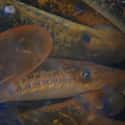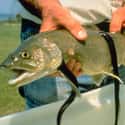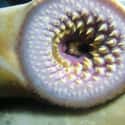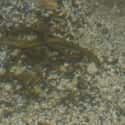(#11) Sea Lampreys Only Have One Enemy - Humans
Besides humans, there are no other known predators that hunt sea lampreys. This gives the lamprey a great advantage towards strengthening their species and living fuller lives. However, they aren’t exempt from hosting parasitic invaders that could inevitably kill them. Studies conducted from select regions of the Great Lakes found most lampreys carried mild traces of nematode parasites and only proved to be damaging towards the end of a lamprey’s life. The two most common nematodes lamprey are known to carry are roundworms and flatworms. Still, out of the two parasites, roundworm infestations are reported as being the only parasitic invader to cause the most severe damage to lamprey.
(#4) Parasitic Sea Lamprey Destroy The Environment
The sea lamprey is considered to be a parasitic fish because it bores holes into its prey while feeding on their blood and bodily fluids, slowly killing their prey and damaging the species overall survival rate. In fact, a single parasitic lamprey can kill over 40 pounds or more of fish in its lifetime.
The impact that sea lampreys pose to the ecosystem greatly threatens the lives of the many fish it prefers to feed on, such as the lake sturgeon. Because of the sea lamprey's horrendous feeding habits on lake sturgeons, the sturgeon has been marked on the threatened and endangered species list in both New York and Vermont.
(#7) Sea Lampreys Nearly Collapsed Commercial And Recreational Fishing
During the 1940s and 1950s, an explosion of sea lamprey wreaked havoc to the Great Lakes. The invasive species excessively fed on the lake trout, whitefish, and chubs that dwelled there. Because a single adult lamprey can consume a massive amount of fish in its lifetime, a multitude of lamprey feeding on the lake's fish caused a huge epidemic for the commercial and recreational fishing industries. In fact, before the epidemic, more than 15 million pounds of lake trout could be harvested on a yearly basis from the Great Lakes. However, after the invasion, this number fell dramatically and by the 1960’s only 300,000 pounds was harvested from the lakes.
(#1) Sea Lampreys Are Vampires And Suck The Life Out Of Their Prey
The sea lamprey is nicknamed the vampire of the sea, and for good reason. Their wide suction cup mouths allow them to cling onto their host and feed for a prolong time. The lamprey generally vacuums itself onto one spot of their victim's body, making it an effective method to sucks their prey’s bodily fluids and blood. In addition, the proteins in their saliva widen the blood vessels of their prey while their abrasive tongue and piercing teeth damage the skin of its victim and induce blood flow. This allows the lamprey to consume more nutrients and nourishment in a short amount of time
(#13) Not All Lamprey Fish Are Parasitic
The sea lamprey is not the only type of lamprey living in the world. In fact, there are over 40 different species of lampreys that exist on earth. Four of these species are native to North America. And while the invasive, parasitic lampreys get the most attention, not all lamprey fish are parasitic or invasive to the environment. The northern brook and American brook lamprey are non-parasitic. Unlike river and sea lamprey, brook lamprey never become parasitic as adults; they simply mate and die. Non-parasitic lampreys don't deplete the fish population and actually live in balance with the food chain.

(#10) Lampreys Aide Scientist In Modern Medicine
Because of the sea lamprey's genome, which allows them the amazing ability to regenerate nerve endings and regain full motion, the species has become a valuable research subject for scientists. In fact, scientists studying the sea lamprey genome have discovered some genes are linked to human neurological disorders. With this information, more tests and further studying, scientists hope to find cures to restore damaged nerve endings in humans and assist patients suffering from spinal cord injuries, Alzheimer’s, and Parkinson’s diseases. Aside from vertebrae and nerve restoration, the lamprey genome is also being studied for embryonic development and organ differentiation research.
New Random Displays Display All By Ranking
About This Tool
We can not deny that lampreys look very disgusting. They have no upper and lower jaws, and their cylindrical mouths are full of teeth, which is one of the characteristics of ancient fish ancestors. Scientists have confirmed that lampreys are the most primitive vertebrates in the world, but this sea creature has hardly evolved and still maintains its original form and way of survival. They rely on these sharp teeth to suck blood from other fish, and even parasitize other big fish.
We should know that lampreys are not fish, because they look terrifying and become the prototype of many monsters in movies. In fact, lampreys are also edible and taste good. You could find 14 disgusting facts about lampreys in this random tool.
Our data comes from Ranker, If you want to participate in the ranking of items displayed on this page, please click here.














